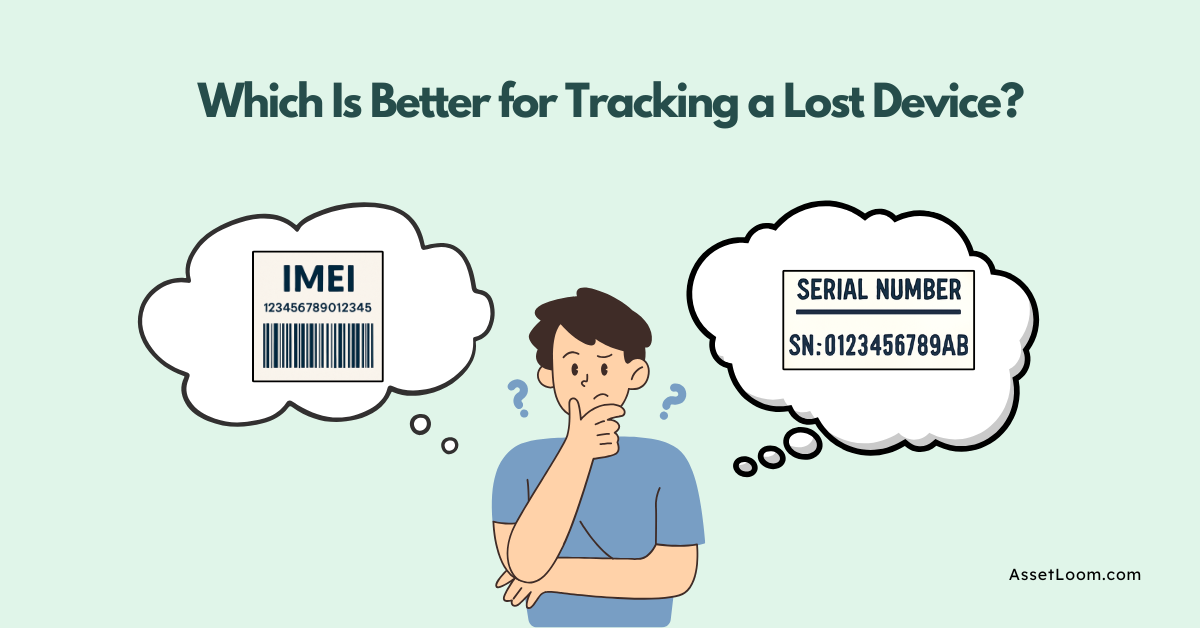IMEI vs. Serial Number: Which Is Better for Tracking a Lost Device?
Wondering how to track a lost device? Learn the differences between IMEI and serial numbers, how each helps with recovery, and which is best for managing your devices, whether personal or corporate.
Have you ever lost your phone or laptop and wished for an easier way to track it down? Whether it's a personal device or a corporate asset, recovering lost or stolen tech can be overwhelming. Thankfully, two key identifiers can help: the IMEI number and the serial number.
In this post, we’ll explore the differences between IMEI and serial numbers, assess their effectiveness in tracking devices, and offer insights for IT managers, asset managers, and tech enthusiasts like you.
By understanding when and how to use each identifier, you’ll be better equipped to manage device security, whether for personal gadgets or organizational assets. Let’s take a closer look at how these tools can help you recover lost devices.
What Are IMEI and Serial Numbers?
1. What is an IMEI Number?
IMEI stands for International Mobile Equipment Identity, and it’s essentially a unique 15-digit code assigned to each mobile device, like your smartphone or tablet. It’s embedded right into the hardware of the device, making it tied directly to the device itself; not to you, the user, or your SIM card.
The real power of the IMEI number comes when you’re trying to track a lost or stolen mobile device. If you report your device as lost or stolen, your network provider or even law enforcement can use the IMEI to locate, block, or blacklist the device, rendering it unusable on most cellular networks. This makes the IMEI super important for protecting your device on a global scale.
Example: Imagine your phone gets stolen while you’re traveling. If you report the IMEI number to your provider, they can block it, preventing the thief from using your phone on any network.
2. What is a Serial Number?
A serial number is also a unique code, but it’s usually a mix of letters and numbers. It’s assigned by the manufacturer and serves to distinguish one device from another in their system. Think of it like a fingerprint for your device. You’ll often see serial numbers used for things like inventory tracking, warranty claims, and service requests.
Unlike IMEI, serial numbers are used across a much wider range of products; not just mobile phones. They apply to things like laptops, printers, home appliances, and even some hardware components. While serial numbers can help identify a device, they won’t help you track it down in real-time like IMEI does. Instead, they’re more useful for managing things like product lifecycles and warranties within the manufacturer’s system.
Example: If your company laptop gets misplaced at work, the serial number can help confirm who owns it, but it won’t tell you where it is.
3. Key Difference Between IMEI and Serial Numbers:
- Scope of Use:
IMEI is really only for mobile devices like smartphones and tablets, and it's tied directly to network services, so it can be used to track the device across cellular networks.
Serial numbers, on the other hand, are used for a much broader range of electronics: laptops, printers, desktops, and even home appliances. They’re mainly used by manufacturers for tracking inventory and handling service requests.
- Tracking Capability:
IMEI gives you the ability to track a device in real-time through the mobile carrier network. So, if your phone goes missing, the IMEI can be used to locate it or block it.
Serial numbers are good for identifying a device, but they won’t let you track it in real-time. They’re more about keeping track of a device’s warranty, service history, and ownership.
- Device Types:
IMEI is specific to mobile devices, like smartphones and tablets, that rely on cellular networks.
Serial numbers apply to a broader array of devices, from mobile gadgets to appliances and even hardware components.
How Do IMEI and Serial Numbers Help in Device Tracking?
When it comes to tracking a lost or stolen device, both IMEI and serial numbers play important roles. However, the way they help can differ a lot. Here’s how each one works:
1. IMEI Tracking: How It Works
The IMEI number is your best friend when it comes to tracking a lost or stolen mobile device.
Here’s why: If your phone or tablet goes missing, you can report its IMEI number to your mobile carrier or network provider. From there, they can track your device through the cellular network and, in some cases, even pinpoint its location. This can be done through the provider’s system, allowing them to block the device from being used on their network. This is particularly useful if you’re trying to recover a stolen phone.
Example: If your phone is stolen while you're on vacation, you can report the IMEI number to your provider, and they’ll block it. Some carriers even help law enforcement track it down if necessary.
IMEI doesn’t just work locally, either; it's recognized internationally. So, even if your device is taken to a different country, it can still be tracked and blocked through the same process.
2. Serial Number Tracking: How It Works
While serial numbers don’t offer the same real-time tracking as IMEI, they’re still incredibly valuable for identifying and managing devices.
When a device is lost or misplaced, serial numbers help confirm ownership and can link the device to your inventory system. If your company laptop goes missing, for example, you can use the serial number to find out where it was purchased, who it was assigned to, and whether the manufacturer can help recover it.
But unlike IMEI, serial numbers won’t help you pinpoint the device's current location. They're more useful for keeping track of devices within an organization’s asset management system or for warranty and repair tracking with the manufacturer.
Example: If your company laptop is left behind in a café, you can search the manufacturer’s database using the serial number to help track its ownership. However, you won’t be able to track it like you would a stolen phone with an IMEI.
=> How to Track a Stolen Laptop with Serial Number: Step-by-Step Guide
IMEI vs. Serial Number: Which Is Better for Tracking a Lost Device?
Now that we know how IMEI and serial numbers work, let’s dive into the strengths and weaknesses of each. Understanding these will help you figure out which one is better for your specific needs.

1. IMEI Number: Pros and Cons
Pros:
- Real-time Tracking: The biggest advantage of an IMEI number is its ability to track a device in real-time. Once you report the IMEI number to your carrier, they can use it to locate your device or block it from being used on any network. This is especially useful if your mobile device is stolen or goes missing.
- Global Reach: IMEI numbers are recognized worldwide, so if your device gets stolen and ends up in another country, it can still be tracked or blacklisted by your carrier.
- Security: IMEI can be used to lock the device remotely, making it a useful tool for preventing unauthorized use if your device is lost or stolen.
Cons:
- Limited to Mobile Devices: The IMEI number only applies to mobile devices like smartphones and tablets. It’s not something you’ll find on a laptop or printer, so it’s not universally useful across all types of electronics.
- Carrier Dependence: To track or block a device using IMEI, you rely on your carrier or law enforcement, which can sometimes take time or not be as effective in certain regions.
- Device Reset: If the device is factory reset, the IMEI can still be tracked, but if the device is wiped and the SIM card is removed, tracking becomes more difficult.
2. Serial Number: Pros and Cons
Pros:
- Versatility: Serial numbers are found on a wide variety of devices, from smartphones to laptops, printers, and even home appliances. They are used across many product categories, making them helpful for keeping track of a range of assets.
- Simple Identification: Serial numbers are incredibly useful for identifying a device, especially in asset management systems. If a device goes missing, the serial number can confirm who owns it and, in some cases, help with warranty claims or servicing.
- No Network Dependency: Unlike IMEI, serial numbers don’t rely on network services to function. They can be used to track devices through manufacturer databases or internal systems without needing any external infrastructure.
Cons:
- No Real-time Tracking: While serial numbers help with identifying devices, they don’t offer the real-time tracking capabilities that IMEI provides. You won’t be able to locate a device in real-time just by using the serial number.
- Limited to Manufacturer Systems: Serial numbers are mainly useful within the manufacturer's database or your organization’s asset management system. They don’t work for tracking a device through external channels like cellular networks or law enforcement.
- Not Effective for Stolen Devices: If your device is stolen, the serial number can help identify it but won’t help you locate or block it. It's primarily useful for warranty and repair tracking, not for theft recovery.
In conclusion, Both IMEI and serial numbers have their unique strengths. IMEI excels in tracking and securing mobile devices with real-time capabilities, but is limited to phones and tablets. Serial numbers, used across a broader range of electronics, are great for device identification and asset management but don’t offer real-time tracking. Depending on your needs, each serves an important role. Next, we’ll look at which option is best for different scenarios, whether for personal devices or managing company assets.
Which is Better for Different Scenarios?
Whether you’re tracking a personal device, managing a company’s assets, or dealing with theft, the choice between IMEI and serial numbers depends on the scenario. Here’s how each identifier shines in different contexts:
1. Personal Devices:
If you’re looking to track a smartphone or tablet, the IMEI number is your best bet. It’s tied directly to the mobile network, allowing your carrier or law enforcement to track, block, or blacklist a stolen device. So, if your phone gets stolen, reporting the IMEI number to your service provider gives you a real chance at recovering it or at least preventing the thief from using it.
Example: You’re on vacation, and your phone is stolen. If you report the IMEI to your network provider, they can block the device, making it useless to the thief.
2. Corporate Asset Management:
When it comes to company-owned devices, like laptops, desktops, or printers, serial numbers are a key part of asset management. They help you track which devices belong to which employees, assist with warranty claims, and ensure proper servicing. While you won’t get real-time tracking with a serial number, it’s invaluable for maintaining a complete inventory and for identifying devices if they go missing or need repairs.
Example: If an employee leaves their laptop at a café, the serial number can help your IT department identify and recover it, though it won’t help track its location in real time.
3. When a Device Is Stolen:
If a mobile device is stolen, IMEI tracking is your best option. With a IMEI, your carrier or law enforcement can attempt to locate the device and block its usage. Unfortunately, serial numbers don’t offer this kind of real-time tracking or blocking ability, making them less effective when dealing with theft.
Example: A laptop gets stolen. The serial number will help identify it in a database, but it won’t help recover it unless it’s returned to the manufacturer or you’ve registered it within an asset management system.
Best Practices for Tracking Lost Devices in Your Organization
It’s important to look at how to implement these tools effectively within your organization. Here are some best practices to ensure you’re tracking your devices properly, minimizing losses, and securing your assets.
![]()
- Document Device Identifiers: Ensure all IMEI and serial numbers are recorded in a centralized database for quick access when needed. This allows for fast action if a device is lost or stolen.
- Use Asset Management Software: Utilize IT asset management tool like AssetLoom to store and manage IMEI and serial numbers. It helps track device status and lifecycle, ensuring devices are accounted for and easily retrievable.
- Integrate MDM Tools: Use Mobile Device Management (MDM) software for mobile devices. It lets you remotely lock, track, or wipe a device, enhancing security and recovery with IMEI tracking.
- Create a Response Plan: Develop a clear plan for lost devices, including steps like reporting the IMEI to your carrier and logging the incident in your asset management system.
=> How to Track a Lost Laptop?
Conclusion
Both IMEI and serial numbers serve critical roles in tracking and managing devices, but their strengths and uses differ. IMEI is ideal for tracking mobile devices in real-time, helping you recover stolen phones or tablets by blocking them on networks. Serial numbers, on the other hand, are perfect for identifying and managing a wide range of devices, from laptops to printers, within your organization or through manufacturer systems.
For personal devices, IMEI is your go-to for tracking and securing lost gadgets. In a corporate setting, serial numbers are invaluable for asset management and warranty tracking. By leveraging both, you can create a robust strategy for device protection, recovery, and management.

Subscribe for Expert Tips and Updates
Receive the latest news from AssetLoom. right in your inbox


